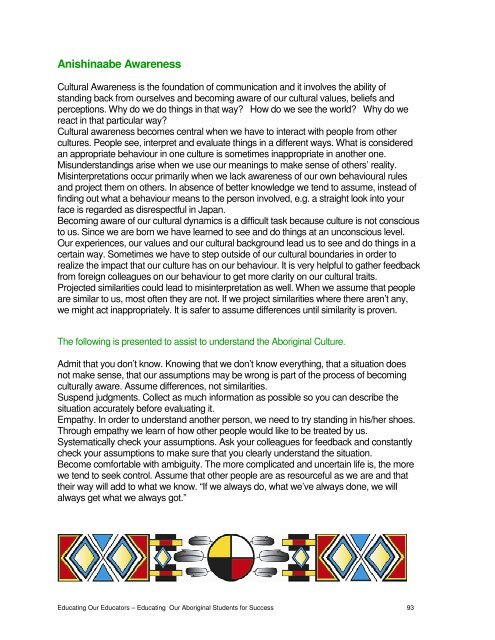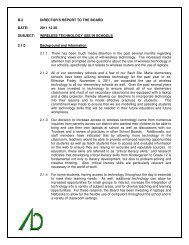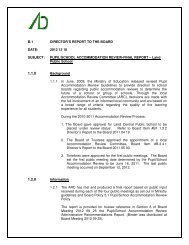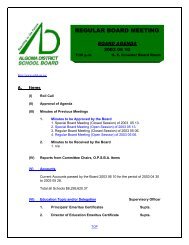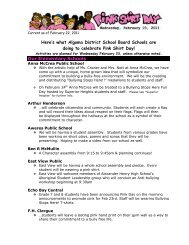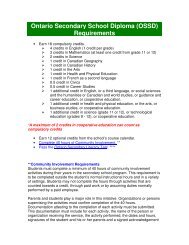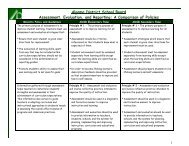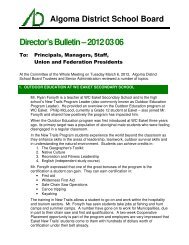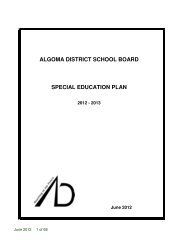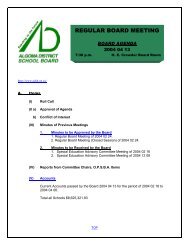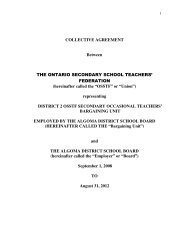Educating Our Educators Guide for Staff - Algoma District School ...
Educating Our Educators Guide for Staff - Algoma District School ...
Educating Our Educators Guide for Staff - Algoma District School ...
- No tags were found...
You also want an ePaper? Increase the reach of your titles
YUMPU automatically turns print PDFs into web optimized ePapers that Google loves.
Anishinaabe AwarenessCultural Awareness is the foundation of communication and it involves the ability ofstanding back from ourselves and becoming aware of our cultural values, beliefs andperceptions. Why do we do things in that way? How do we see the world? Why do wereact in that particular way?Cultural awareness becomes central when we have to interact with people from othercultures. People see, interpret and evaluate things in a different ways. What is consideredan appropriate behaviour in one culture is sometimes inappropriate in another one.Misunderstandings arise when we use our meanings to make sense of others’ reality.Misinterpretations occur primarily when we lack awareness of our own behavioural rulesand project them on others. In absence of better knowledge we tend to assume, instead offinding out what a behaviour means to the person involved, e.g. a straight look into yourface is regarded as disrespectful in Japan.Becoming aware of our cultural dynamics is a difficult task because culture is not consciousto us. Since we are born we have learned to see and do things at an unconscious level.<strong>Our</strong> experiences, our values and our cultural background lead us to see and do things in acertain way. Sometimes we have to step outside of our cultural boundaries in order torealize the impact that our culture has on our behaviour. It is very helpful to gather feedbackfrom <strong>for</strong>eign colleagues on our behaviour to get more clarity on our cultural traits.Projected similarities could lead to misinterpretation as well. When we assume that peopleare similar to us, most often they are not. If we project similarities where there aren’t any,we might act inappropriately. It is safer to assume differences until similarity is proven.The following is presented to assist to understand the Aboriginal Culture.Admit that you don’t know. Knowing that we don’t know everything, that a situation doesnot make sense, that our assumptions may be wrong is part of the process of becomingculturally aware. Assume differences, not similarities.Suspend judgments. Collect as much in<strong>for</strong>mation as possible so you can describe thesituation accurately be<strong>for</strong>e evaluating it.Empathy. In order to understand another person, we need to try standing in his/her shoes.Through empathy we learn of how other people would like to be treated by us.Systematically check your assumptions. Ask your colleagues <strong>for</strong> feedback and constantlycheck your assumptions to make sure that you clearly understand the situation.Become com<strong>for</strong>table with ambiguity. The more complicated and uncertain life is, the morewe tend to seek control. Assume that other people are as resourceful as we are and thattheir way will add to what we know. “If we always do, what we’ve always done, we willalways get what we always got.”<strong>Educating</strong> <strong>Our</strong> <strong>Educators</strong> – <strong>Educating</strong> <strong>Our</strong> Aboriginal Students <strong>for</strong> Success 93


